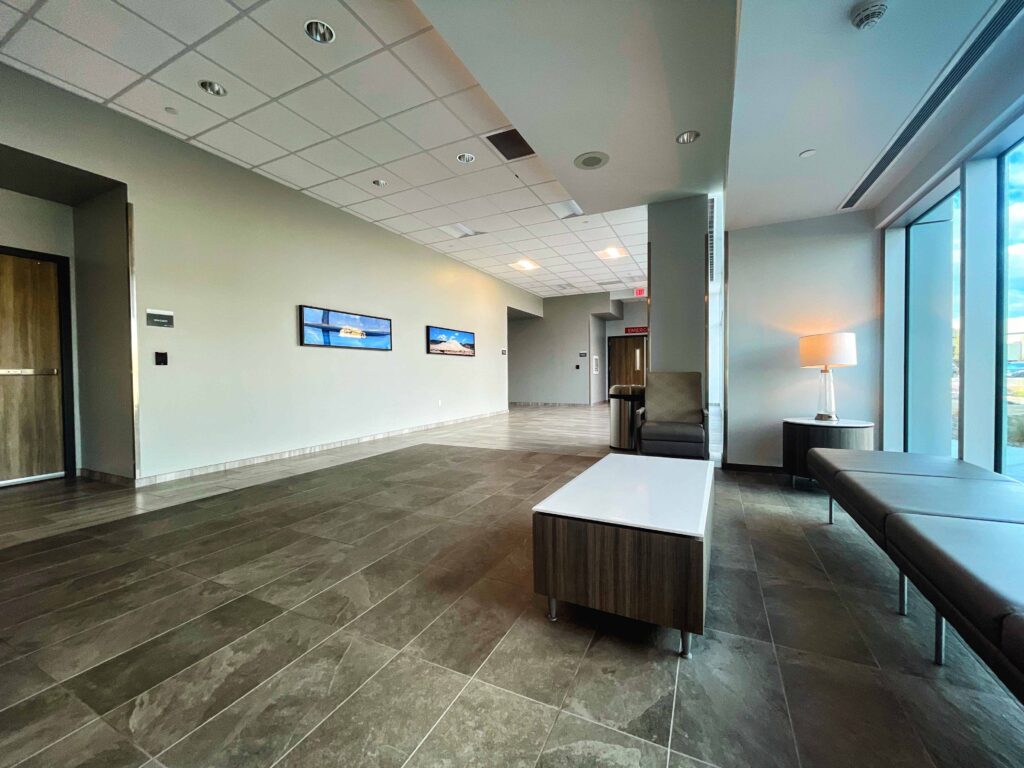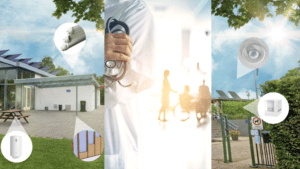

Sustainability in healthcare: the latest trends and developments
Care homes, day centres and other care premises: they have in some cases been around for a long time. Older properties are usually not equipped with the best insulation or the latest energy-efficient equipment. Add to this the fact that healthcare facilities have relatively high energy bills due to intensive use, and it becomes clear: energy efficiency measures are a major focus point for greater sustainability in healthcare.
Consequently, in recent years, healthcare organisations have been increasingly urged to become more sustainable. This is not only the result of legal considerations with legislation on energy efficiency and reporting, but economic factors also play a role. Rising gas and energy prices, for example, also encourage taking sustainability measures in healthcare buildings.
Sustainable trends in healthcare
Recently, there have been several developments stimulating sustainability in healthcare. Five trends are listed below:
1. The accelerating impact of the Sustainable Healthcare Green Deal
The Sustainable Healthcare Green Deal was recently concluded. This agreement creates joint commitment and also ensures that signatories periodically report on the energy usage of their real estate portfolio. The Green Deal was signed by many parties in the healthcare sector, resulting in automatic and easier compliance. After all, the Green Deal is already spurring them into action.
Because of the various legal obligations regarding reporting of energy usage and efficiency measures, insight has ceased to be a ‘nice to have’ for healthcare organisations. It is no longer workable to constantly retrieve figures using Excel files, so a well-functioning energy management system has become more or less a necessity.
2. New subsidy opportunities
Another trend can be found in subsidies such as those for Sustainable Social Real Estate (DUMAVA). They are accelerating sustainability efforts, especially in healthcare. The popular DUMAVA subsidy will remain in place until 2030, offering 30% reimbursement of investment in sustainability measures and up to 50% for energy advice and EPCs. As such, it provides an impetus to projects that have stalled.
Do you want to know more about DUMAVA? Check out here 4 tips to successfully apply for DUMAVA.
3. Efficient sustainability measures thanks to portfolio approach
Another positive development that further encourages sustainability in healthcare is the portfolio approach currently being tested. Whereas current legislation requires healthcare organisations with, say, 1,000 owned properties to report and take measures at building level, the portfolio approach greatly reduces the reporting burden. This means setting targets at portfolio level, allowing healthcare organisations to choose which buildings they will invest in with sustainability measures and which not, or less.
Besides significantly reducing the reporting burden, the portfolio approach offers opportunities for greater efficiency. It allows you to create and implement a comprehensive sustainability plan for some buildings in your portfolio, while in other buildings no measures will yet be taken. This is because savings are measured in kWh per m² rather than per building.

Are you curious to know how CFP Green Buildings can help make your portfolio more sustainable? Read more about our Portfolio Analysis, which allows you to analyse large property portfolios in terms of their energy performance and carbon emissions.
4. Measuring using the new WEI indicator
When talking about measurement and reporting, another development comes into play. Whereas previously different indicators were used in various guidelines and roadmaps, the government is now increasingly targeting kWh per m². This is expressed as the actual energy intensity (WEI) indicator.
“Today, we are increasingly seeing a focus on actual energy usage. kWh per m² is the means of measuring this and will play a more important role in legislation and the resulting obligations for building owners in the years ahead.”
– Youp van der Zande, Consultant at CFP Green Buildings
For example, the EED focused on gigajoules and other guidelines centred on CO₂. It is expected that this will increasingly be replaced by one and the same way of measuring. This WEI indicator also entails a certain ambition and guidelines will, for example, start requiring kWh per m² to be reduced to a set level. So if you can measure, report and manage these values for your healthcare premises, you will be well prepared for the future.
5. Critically examining own property
The above portfolio approach offers opportunities to implement sustainable investments in the most cost-effective way. This may mean that some buildings will not be made more sustainable, for example because they will eventually be disposed of.
Another reason for healthcare organisations to take a critical look at their own real estate is, for example, climate change. Increasing temperatures in summer lead to comfort problems in buildings with relatively poor insulation and a need for more cooling, which care buildings cannot always provide. This may cause residents to install mobile air conditioners themselves, with an increase in energy usage as a result. The following issue then arises for healthcare organisations: are we going to invest in better cooling ourselves to bring comfort for users up to standard, or should we consider disposing of this property? Extra sustainability measures often offer a solution, but a critical examination can also lead to the realisation that it is not worth it.
How to get sustainability off the ground
Many sustainability measures for existing buildings are now cost-effective, e.g. solar panels and LED lighting. Thanks to their short payback period, these investments no longer have to debated in many cases, which further accelerates sustainability.
Besides developments that can boost sustainability in healthcare, there are also factors that can hinder it. In smaller healthcare organisations, for example, there is not always a sustainability coordinator, but sustainability and energy savings are addressed by the real estate department. Because of the large reporting burden and many deadlines, an external agency is often engaged, leading to the topic becoming less embedded in the organisation.
To monitor energy usage and reduce the reporting burden, there are several online tools that can help. For example, MeterInsight has designed a new software programme to make it easier for smaller organisations in particular to invest in sustainability as efficiently as possible. In addition, for larger healthcare organisations, there is the Green Buildings Tool, which allows you to easily and quickly obtain the right insights at portfolio level. Are you curious about how you can become more sustainable more efficiently? Then contact us for customised advice.






